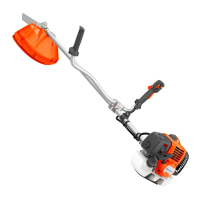What to do if the spark plug is loose on my Husqvarna Brush Cutter?
- RRyan MooreSep 7, 2025
If the spark plug on your Husqvarna Brush Cutter is loose, tighten the spark plug.

What to do if the spark plug is loose on my Husqvarna Brush Cutter?
If the spark plug on your Husqvarna Brush Cutter is loose, tighten the spark plug.
What to do if the air filter is clogged in my Husqvarna Trimmer?
If the air filter of your Husqvarna Trimmer is clogged, clean it to resolve the issue.
What to do if the spark plug is loose on my Husqvarna Trimmer?
If your Husqvarna Trimmer's spark plug is loose, tighten it.
How to fix no spark on a Husqvarna Trimmer?
If there is no spark in your Husqvarna Trimmer, ensure the spark plug is dry and clean. If the problem persists, clean the spark plug, check that the electrode gap is correct, and ensure the spark plug is installed with a suppressor. Refer to technical data for correct electrode gap.
| Engine Type | 2-stroke |
|---|---|
| Weight | 5.2 kg |
| Sound Pressure Level | 94 dB(A) |
| Fuel Tank Volume/Capacity | 0.5 L |
| Recommended Cutting Equipment | Grass blade, trimmer head |
| Engine Displacement | 30.1 cm³ |
Describes the brushcutter and its primary function for grass trimming and clearing.
Explains the proper applications for the brushcutter, specifying approved cutting attachments.
Explains the meaning of various safety symbols and warnings found on the product.
Details conditions under which the manufacturer is not liable for damages caused by the product.
Defines severity levels for safety signals like WARNING and CAUTION.
Provides essential safety guidelines for product operation, handling, and maintenance.
Details necessary PPE for safe operation, including eye, ear, and foot protection.
Highlights the importance of maintaining product protective features for safety.
Explains the function of the throttle trigger lockout to prevent accidental acceleration.
Outlines the procedure to verify the safety quick-release mechanism.
Stresses the importance of using and checking the cutting attachment guard.
Describes the muffler's role and safety precautions related to its operation.
Provides instructions for securely attaching and removing cutting attachments using the locknut.
Discusses choosing and maintaining cutting attachments for optimal performance.
Offers guidance on using trimmer heads and trimmer lines correctly.
Details the use and safety precautions for grass blades and cutters.
Explains the phenomenon of blade thrust and associated risks.
Provides critical safety guidelines for handling and using fuel with the product.
Step-by-step guide to connect the engine to the main tube.
Instructions for fitting the handlebar and clamp onto the shaft.
Procedure for connecting the throttle cable and stop switch wires to the carburettor.
Guide on how to attach cutting blades and trimmer heads to the output shaft.
Steps for attaching the blade guard and grass blade assembly.
Instructions for mounting the bracket onto the cutting attachment guard.
Steps to attach the trimmer guard and connect the trimmer head to the shaft.
Guide on how to attach the transport guard for blades.
Instructions for properly adjusting the harness for comfortable and safe operation.
Safety precautions and guidelines for using fuel with the product.
Specifics on the type of gasoline to use and warnings about its use.
Instructions for correctly mixing gasoline and two-cycle engine oil.
Safety procedures for refuelling the product.
Detailed steps for starting the engine when it is cold.
Instructions for starting the engine when it is already warm.
Guidance on how to operate the grass trimmer effectively.
Provides general advice for efficient and safe operation.
Techniques for clearing grass using the grass blade attachment.
Tips for clearing an area effectively with the trimmer.
Instructions on how to trim grass using the trimmer head.
Steps for cutting grass using the trimmer line.
Using trimmer airflow to clear cut grass from an area.
Reference for instructions on how to replace the trimmer line.
A schedule outlining daily, weekly, and monthly maintenance tasks.
Instructions for adjusting the carburetor, recommended for trained technicians.
Procedures for inspecting the muffler for damage and proper attachment.
Guide to setting the correct idle speed for the engine.
Explains the cooling system components and their function.
Steps for cleaning the product's cooling system to prevent overheating.
Information on the air filter and its cleaning intervals.
Detailed instructions for cleaning and maintaining the air filter.
Guidance on checking and maintaining the fuel filter.
Instructions for properly lubricating the bevel gear.
Method for sharpening cutting attachments to maintain balance and performance.
Lists possible causes and solutions for engine starting failures.
Addresses issues where the engine starts but stops unexpectedly.
Guidelines for safely transporting and storing the product.